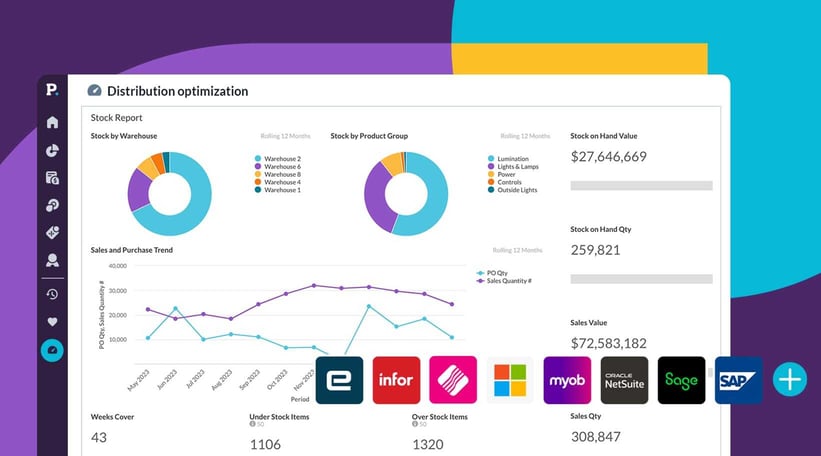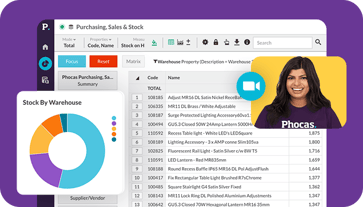How to extract data from ERP systems
Most manufacturers, distributors and retailers run on enterprise resource planning (ERP) systems. These powerful platforms manage everything from finance to human resources and customer information. Yet, one of the most common complaints is how difficult it is to extract data from an ERP system.
Without an automated way to pull ERP data, many companies resort to the same workaround which is dumping data into spreadsheets. While Excel is familiar and flexible, relying on manual spreadsheets is time-consuming, error-prone and makes it hard to maintain data accuracy. Businesses often need a better way to combine and analyze ERP data to build reports and streamline budgets.
Why ERP data extraction is so hard?
ERP systems are specialized, complex tools designed to handle huge amounts of data across multiple modules like inventory management, invoicing, sales and human resources. Each ERP is typically configured to suit a company’s unique business processes and workflows.
That customization is powerful but it creates a major challenge – there's no existing standard method to extract ERP data. Every company’s ERP system has its own data structure, validation rules and connectors, making it difficult to offer simple integrations.
Even standard SQL queries or traditional ETL (extract, transform, load) processes don't work because of data duplication, security considerations and the risk of breaking core business operations. So, ERPs are great at running businesses but not always great at letting go of the data inside them because that’s how they were designed.
Why extraction varies across ERPs
If you’ve worked with different ERP software, you’ll know the extraction process is nuanced. Based on Phocas' experience working with leading ERPs over the years, here are a few examples of how data integration varies.
NetSuite
NetSuite makes use of APIs for real-time data sharing. However, the APIs can be limited in scope and need careful configuration to meet specific business needs.
Phocas is a NetSuite SuiteCloud Developer Network Partner so has created specific integrations to work with available APIs and saved searches, providing consolidated reporting and analytics that enhance visibility across finance, sales and inventory management.
SAP
SAP is known for its comprehensive functionality and complexity, SAP often requires dedicated connectors or APIs. Extracting ERP data typically involves working with SAP’s proprietary data warehouses like Hana and navigating strict data security protocols.
Phocas works with SAP customers to configure tailored data feeds, ensuring that essential modules like finance and sales flow seamlessly into intuitive dashboards.
Microsoft
Microsoft’s ERP suite including Dynamics NAV and Business Central is built on a SQL Server backbone and offers flexibility but extracting data can still pose challenges, especially for teams without technical resources.
For Dynamics NAV, Phocas uses a SQL-based integration and for Dynamics Business Central or Dynamics 365, Phocas often uses API or database connectors as part of our Sync Client or connector framework. This method securely extracts data and applies validation to support the BI and FP&A platform.
Sage
While Sage supports reporting and exporting options, automating extraction across different modules like accounting, inventory and CRM often requires custom scripts or third-party integration tools.
For Sage Intacct, Phocas uses its prebuilt connector to read data via the Sage API, then maps your custom fields and business rules during implementation for analysis-ready datasets.
Epicor
Epicor offers SQL-based access to its database but businesses must be careful with direct queries that might affect business operations or compromise data accuracy.
Phocas provides purpose-built Epicor connectors that safely extract ERP data into the white-labelled Epicor Data Analytics Suite powered by Phocas.
Infor
Known for industry-specific ERPs, Infor provides APIs and integration options but because each deployment is highly tailored, data sources and structures can vary widely.
Phocas provides an Infor-ready data integration and is accredited on Infor Marketplace, pulling Infor ERP data into the Phocas BI and FP&A platform. Implementations use Phocas connectors to read the approved tables or API endpoints, apply business rules and schedule refreshes. This approach is designed to handle complex datasets.
MYOB
Popular with small to mid-sized businesses, MYOB typically requires exports into spreadsheets or connections via third-party integration tools.
For MYOB Advanced (Acumatica) Phocas uses prebuilt integrations that read via the vendor APIs, centralizing finance, sales and inventory data in Phocas.
This diversity highlights the challenge that even when two companies use the same ERP, the way they extract data may differ based on how customized it is or the data structures in place.
How APIs can help if you have the expertise
As technology evolves, most ERPs provide application programming interfaces (APIs) to simplify data extraction and integration. APIs allow businesses to:
-
Automate the flow of data between the ERP system and other tools like CRMs, BI platforms or data warehouses.
-
Provide real-time data access, improving reporting accuracy and allowing people to be up-to-date with current customer behaviour so can make timely decisions about inventory and pricing.
-
Enable businesses to build dashboards that combine ERP data with information from other data sources, giving a complete view of operations.
-
Reduce reliance on manual spreadsheets, minimizing errors from duplication and manual validation.
APIs and automated ETL processes can encounter challenges such as poor mapping resulting in missing fields, inconsistent validation or incorrect workflows. Then as ERPs update or evolve, connectors and ETL pipelines may break, requiring ongoing attention. As businesses grow, the volume of ERP data can overwhelm poorly designed ETL processes and automated processes that bypass ERP controls can expose sensitive financial or human resources data.
The hands-on Phocas approach
At Phocas, we’ve built our reputation on helping businesses go beyond the standard approach to ERP data integration. Instead of relying solely on generic APIs or rigid ETL techniques, we take a hands-on approach. Our integration team works with every new customer to ensure every field is properly configured and every database matched.
From supply chain to inventory management, we help businesses bring their ERP data into one easy-to-use platform so decision-making is fast and accurate.
This commitment to customer success is why Phocas implementation people are well liked and helpful. This recognition from Bapco for excellent implementation was particularly touching as normally they only recognize internal staff but our Phocas consultant was so valued they made an exception. Customers trust us because we carefully implement as well as support ongoing data management, ensuring the ERP integration works and scales with their business.
Extracting data from an ERP system is rarely straightforward. With so many different ERP platforms with unique data structures, modules and workflows, it is common for businesses to struggle to integrate and automate their data. While APIs and ETL processes offer powerful solutions, they come with pitfalls that require careful planning and expertise.
By working with an integration partner and software provider like Phocas businesses can turn their ERP data into a strategic advantage via clear reports and up-to-date results.


Katrina is a professional writer with a decade of experience in business and tech. She explains how data can work for business people and finance teams without all the tech jargon.
Related blog posts

Enterprise resource planning (ERP) systems are at the core of operational success. They help manage data and transactions across finance, your supply chain, human resources, procurement and sales. But for many organizations, the reality isn’t as simple as having a single ERP. Due to mergers and acquisitions, geographic expansion or divisional differences, companies often find themselves running multiple ERP systems. This way of operating comes with complexities as each system has its own functions, workflows and data formats.
Read more
Just as every cog and gear must turn with precision to be viable, a manufacturer has another necessary business tool, the ERP. Manufacturing operations were offered a digital boost in the 90s when enterprise resource planning (ERP) software came into use and the software continues to be relied on today for end-to end manufacturing management.
Read more
Phocas Software helps Sage customers gain more insights from their business Phocas Software, a business planning and analytics platform for sales, operations, and finance teams, announced a new technology partnership with Sage, the leader in accounting, financial, HR, and payroll technology. Phocas products are now integrated with Sage Intacct, making it easier for companies to access, analyze, report, and share information in their systems.
Read moreBrowse by category

Find out how our platform gives you the visibility you need to get more done.
Get your demo today